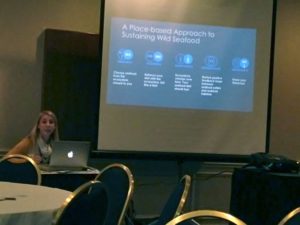Hospital food. School cafeteria food. Few menus instill as much dread, appetite aversion or standup comic material.
Fortunately, the farm/boat to table movement continues to grow, beyond the individual consumer to institutions. This message was boldly apparent at the Farm to Institution New England conference last week held in Leominster, Mass.
More than 400 representatives from various parts of the food system discussed many issues, challenges and solutions to streamlining the path for good, locally produced food to New England institutions like schools and healthcare facilities.
While this sounds like a fairly straightforward proposition, the process is by no means easy. Breaking decades of habit- and price-based sourcing patterns from national distributors while changing menus and “customer” palates takes time, patience, lots of education and some trial and error. Education of the palate can be one of the steeper challenges. How are you going to convince a bunch of middle school students to eat pollock?
There’s hake in that burger!
First, you have to make it tasty, and create a dish that is recognizable. For example, Cape Ann Fresh Catch Executive Director Donna Marshall has brought fish burgers and chowder into cafeterias for students to try. She rarely has any leftovers, and the sampling has led to seafood from Cape Ann Fresh Catch prepared and served in these cafeterias.
At the FINE conference, Jennifer Devivo, head chef at the Up Island Regional School District on Martha’s Vineyard described how she plays a game with her elementary and middle school students to guess what the fish of the day on Fridays will be. While eating locally harvested oysters or fried dogfish, students learn about who harvested the seafood (often a neighbor) how and when it was caught, and what role that species plays in the ecosystem.
It’s all in the narrative.
Finding balance
At the FINE Summit I was fortunate enough to moderate a panel about balancing institutional seafood demand with what’s locally available…and abundant. We engaged session attendees in an interesting discussion about abundance. The stock health of different species plays a critical role in eating with the ecosystem, or eating what’s locally available throughout the different seasons and migratory shifts in the ocean.
Titled Eating with the Ecosystem, the discussion began with me providing a brief overview of the regional, domestic and global seafood systems: more than 90% imported to the U.S., the average seafood travels more than 5,000 miles from boat to plate, we’re now growing more seafood for consumption than we’re harvesting, etc. I explained that all of these factors have an impact not just on the resource, but on fishermen and their communities.

Kate Masury discusses the concept of eating with the ecosystem. Credit: Brett Tolley
Kate Masury, program manager of Eating with the Ecosystem, a Rhode Island non-profit promoting a place-based approach to sustainable seafood, discussed recent research from the University of Rhode Island. The study compares the relative abundance of several species in the Gulf of Maine to how much of that species is landed. This ratio gives a visual of roughly what species are most abundant here because they are being harvested less.
Dogfish are at the top of the list, which is no surprise. However, 99% of U.S. caught dogfish, which by the way is delicious fried, is exported for … you guessed it, fish and chips. Lobsters, on the other hand, while still plentiful, are harvested at a high rate that fisheries managers say is sustainable. Hake, skate and scup were also under-harvested relative to abundance.
Bringing local, abundant seafood to hospitals and schools
Next, John Stoddard, healthy food in health care coordinator for Health Care Without Harm, explained some of the challenges and successes in working with healthcare institutions to choose locally harvested, abundant seafood. He pointed to Boston Medical Center and Massachusetts Eye and Ear as regional facilities sourcing seafood from Cape Ann Fresh Catch and the Gloucester Fishermen’s Wives Association.
Bob Bankhert, chef de cuisine at University of Massachusetts Amherst talked about the school’s successes in bringing locally available seafood to students. Here are some of the highlights:
- 3,000 lbs of dogfish per month/ 500 lbs every Friday
- 10,000 lbs of Acadian Redfish per year
- average student consumes 21 lbs of seafood per year, vs. 14 lbs for average American.
- UMASS Amherst ranked #1 by Princeton Review for campus food.
We had thoughtful discussion with session attendees about how to replicate this notion of eating what’s locally available and abundant, and how to get schools and hospitals to follow suit.
Again and again, the conversation kept coming back to telling the story … of the fish, the fishermen and the resource. Getting people to understand their relationship to the resource and the social, economic and ecosystem impacts their decisions have.
I walked away from the session and the conference with the sense the One Fish Foundation mission to expand the sustainable seafood conversation is making progress. This is especially true as we help engage partners like chefs, hospital advocates, community groups and the public around these issues.
